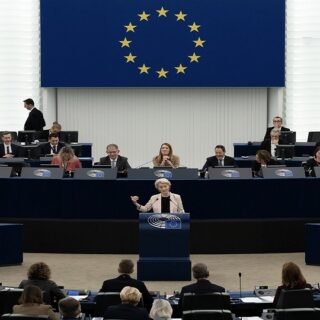
The Reign of Terror in 1793-1794 remains the most controversial chapter of the French Revolution.
Historians are still arguing if the terror of the Jacobin government was an aberration—something gone tragically wrong—or whether the terror was the logical result of the violent and intolerant sentiments expressed by revolutionaries in the early stage of the revolution in 1789.
To say that the Reign of Terror was an aberration and a stain on the history of the revolution means saying that the revolution had its “good” and “bad” stages. Many historians insist that the Jacobins were forced to resort to terror due to foreign military interventions and internal counterrevolutions. Soviet historians used the argument that internal counterrevolutions and foreign intervention forced the Bolsheviks to use terror. These arguments basically absolve both the Jacobins and Bolsheviks of their responsibility for conducting terror.
However, saying that the terror was the logical result of the revolution’s goals and original values means saying that the French Revolution was flawed from the start. The revolution is considered the founding moment in the nation’s history. The Constitution of the Fifth French Republic proclaims “The French people solemnly proclaim their allegiance to the rights of the person and the principles of national sovereignty as defined by the Declaration of the Rights of the Person in 1789.
The constitution also proclaims that the national motto of France is “Liberty! Equality! Fraternity!”, the slogan of the revolutionaries of 1789.[4, 5] However, the intolerant attitude of many revolutionaries in 1789 toward any difference of opinion paved the way for the Reign of Terror.
For many of us, the Reign of Terror is the event that we remember the most about the French Revolution. Many of us have read the novel A Tale of Two Cities by Charles Dickens and seen the movies based on this novel. Nobody can forget how the novel ends with the execution of dozens of people by the guillotine before a cheering crowd.
There can be no doubt about the massiveness of the Reign of Terror. British historian Richard Doyle gave the following statistics of Jacobin repression. Tribunals and other government organs executed 16,000 people while another 16,000 were killed in unofficial executions. Committees and tribunals imprisoned 500,000 people of whom 10,000 died in prison. Another 250,000 men, women, and children were killed by the army in the suppression of the royalist rebellion in the Vendée region from 1793-1796. [1, pp. 253—259] In 1796, General Lazare Hoche reported to the government that 600,000 rebels and French soldiers had been killed in the Vendée rebellion. [2, p. 199]
British historian David Andress has suggested that just as many supporters of the republic were killed during the revolution by their political opponents—at least 200,000 more deaths. [3, p. 6] Note that France had a population of 28 million people in 1789. With more than 500,000 people killed and 500,000 people imprisoned, the Reign of Terror rolled up a record in revolutionary violence that was not matched until the 20th century.
The wars of revolutionary France and the Napoleonic Empire caused more deaths. Between 1792 and 1802, 400,000 French soldiers were killed while another one million between 1802 and 1815. [1, p. 411]
However, despite the appalling statistics, the Reign of Terror of 1793-1794, administered by the ruling Jacobins, was not the only episode of violence in the French Revolution. Violence happened at every stage of the revolution from the storming of the Bastille on July 14, 1789 right up to the coronation of Napoleon Bonaparte as Emperor on December 2, 1804.
Historians have talked about the peaceful period of the revolution from the storming of the Bastille on July 14, 1789 and the overthrow of the Bourbon monarchy in September 1792. However, this period was already marked by different types of violence. French society splintered along political, social, religious, ethnic, linguistic, regional, local, gender, and other lines. Between July 1788 and June 1792, there were 4,700 peasant uprisings directed against the nobility and other landholders. [6, p. 368] There were many riots in the cities especially over poor food supply and rising prices.
Already in 1790, the south of France was the setting for armed conflicts between Catholics and Protestants because Catholics often opposed equal rights for Protestants. There were armed clashes between prorevolutionary and antirevolutionary groupings. Émigrés organized the first royalist conspiracies in the southern region and elsewhere. [7, pp. 101-103]
After the declaration of war against Austria and Prussia and the overthrow of the monarchy in 1792, there were many cases of mass violence. Revolutionaries suspected that political prisoners in the prisons had formed counterrevolutionary conspiracies. In September 1792, radicals in Paris killed 1100-1400 prisoners and radicals throughout France killed hundreds of prisoners. The government did not support these mass killings but did not condemn them. [7, pp. 122-123]
Thus, long before the Jacobin Reign of Terror of 1793-1794, many members of revolutionary, antirevolutionary and counterrevolutionary movements recognized the usefulness of violence and politically motivated killings to achieve their goals.
The Jacobin terror was conducted both in Paris and in the departments (provinces). In Paris, the Committee of Public Safety and Revolutionary Tribunal carried out the terror. The ruling Jacobins often clashed with other revolutionaries opposing mass terror and gave them the abusive name of “moderates”. But the Jacobins also clashed with revolutionaries demanding unrestricted terror. In Paris, the major supporters of terror were the “sans-culottes” — the popular masses consisting of artisans, shopkeepers, small business owners, professional people. The leaders of the “sans-culottes” were often called “the insane ones” by the ruling Jacobins. Although the Jacobins used the hatred of the popular masses toward external and internal enemies, Maximilien Robespierre and other Jacobins strictly controlled the behavior of the masses. They did not allow them to participate in the government or in conducting the policy of terror.
Local Jacobin terror in 1793-1794 in the departments was applied largely in the suppression of “federalist” rebellions which were directed against excessive Paris centralization and the excesses of the local ruling Jacobins. Local Jacobins and representatives of the central government conducted terror, established centralized rule, and often supported the policy of Dechristianization aimed at shutting down churches. Although the local terror was useful to the Paris government, many Paris Jacobins feared that the excesses of local revolutionaries could discredit the revolution. Army repressions were conducted against the Vendée rebels, the Chouans—peasant partisans in Normandy and Brittany, and participants in federalist uprisings.
Anti-Jacobin violence in the provinces had its peculiarities. In the spring of 1793, there were conflicts in many departments between the local Jacobins and their revolutionary opponents. Jacobins accused their opponents of “federalism” — attempting to destroy the unity of the republic. In Lyons and Marseilles, federalists put on trial and executed local Jacobins while royalists in the port of Toulon handed over the port to the British navy. Antirevolutionaries and counterrevolutionaries often participated in “federalist rebellions” [7, pp. 146-233]
The Vendée rebels expelled, beat, and killed all those suspected of winning from the revolution. The rebels directed their violence against Catholic priests who had taken an oath of loyalty to the government, buyers, usually from the bourgeoisie, of confiscated church property, local republican administrators, and members of the local Jacobin clubs. Most of these victims were from the urban bourgeoisie. Mass violence against anybody of winning from the revolution was always conducted in areas of royalist counterrevolutions such as the south of France (Midi) and among the Chouans in Normandy and Britanny. [8, pp. 40-41]
Antirevolutionary and counterrevolutionary violence rose to higher levels after the overthrow of the Jacobins in 1794. Organized vengeance against former Jacobins, suspected of participating in the Reign of Terror, took place in two waves of “White Terror” in the spring of 1795 and spring of 1797 in the south of France. Murder gangs often killed prisoners being transferred from one prison to another or else attacked prisons. The members of the bands called “The Company of the Sun” and “The Company of Jesus” killed people on the streets or elsewhere. Deputies of the Convention (national assembly) and local authorities usually ignored the murder gangs or helped them. The victims included members of the local Jacobin clubs, antireligious activists, poor people, artisans, priests who had taken the loyalty oath, Protestants, and Jews. [7, pp. 248-252] Once again, the victims were usually people accused of winning from the revolution.
Criminal violence skyrocketed because of the breakdown of order. Banditry had always existed in France, but the phenomenon of “royal bandits” emerged in southern France after the overthrow of the Jacobins. The “royal bandits” were usually draft evaders or deserters from the army, and they attacked representatives of the government and army. It was difficult to distinguish these bandits from common criminals. [7, pp. 272-273]
Only severe government measures, including violence, could put an end to the violence of different movements from below. The post-Jacobin Directory and Consulate between 795-1804 used military tactics such as declaring areas under state of siege, using military courts for political opponents, and flying military commissions to put down uprisings, robberies, and royalist uprisings. These tactics were usually applied in the west and south of France.
Along with these traditional military tactics for crushing opposition, the government also established strong surveillance systems and a political police force to suppress opposition and preserve order. These measures, according to American historian Howard Brown, put an end to the French Revolution and established a regime of security that lasted right up to the destruction of the Paris Commune in 1871. [9, pp. 612-613]
Violence from above and below in different forms took place at every stage of the French Revolution from 1789-1804. The next chapter will look at the mentality that made so many people accept violence as a completely legitimate form of obtaining their political goals.
Sources Used
- Doyle, William. The Oxford history of the French Revolution. 3rd ed. Oxford; New York: Oxford University Press, 2018.
- Secher Reynaud. A French Genocide: the Vendée. Trans. from the French. Notre Dame IN: Notre Dame University Press, 2003.
- Andress, David. The terror: civil war in the French Revolution. London: Little, Brown, 2005.
- Texte intégral de la Constitution du 4 octobre 1958 en vigueur.
- Declaration of the Rights of Man https://avalon.law.yale.edu/18th_century/rightsof.asp
- Markoff, John. Violence, Emancipation, and Democracy: The Countryside and the French Revolution. The American Historical Review, Apr., 1995, Vol. 100, No. 2 (Apr., 1995), pp. 360-386.





